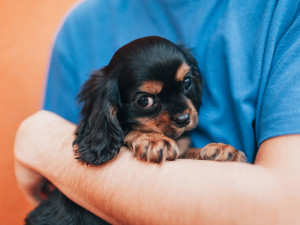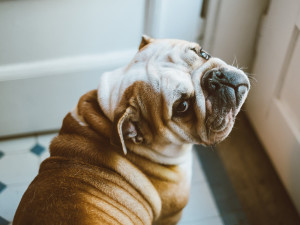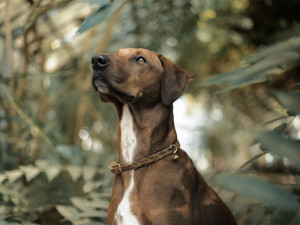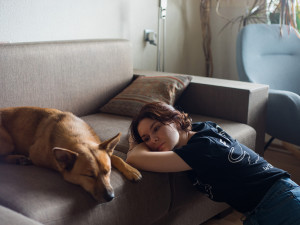Big dogs, Small dogs: Does Size Affect Behavior?
How is the experience of having a large dog different than that of having a small dog?
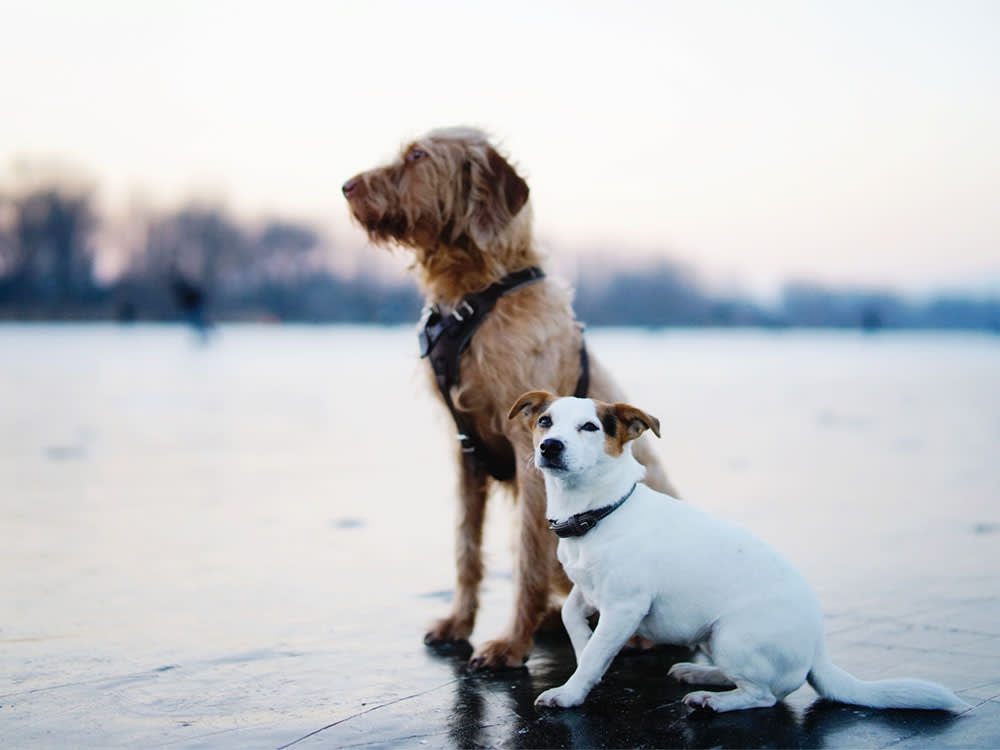
Share Article
When it comes to dogs, size really does matter. While some prefer pocket-sized pupsopens in a new tab for their portability, others like their dogs to be more on the XLopens in a new tab side. Size-based biases are also common. And anyone with big dogs knows that people sometimes fear them even when their behavior is exemplary and a small dog is present whose behavior is not.
One of the marvels of domestic dogs is the astounding range of sizes they come in, which is determined by a very small number of genes. (In comparison, roughly 200 geneopens in a new tab regions affect height in humans.) Since so few genes influence size, how does it affect behavior?

Get (totally free) deals for food, treats, accessories, tech, and way more pet parenting must-haves.
opens in a new tabAre big dogs just compensating for something with their rowdy behavior? Do all small dogs have a superiority complex? Or are people’s behavior and expectations different based on the dog’s size? Here’s everything you need to know about dogs, big and small.
Life with Big Dogs vs. Small Dogs
A dog’s size has practical consequences. Here are a few examples:
Health
Ask anyone with a Great Dane suffering from diarrhea, an experience that’s not quite the same for someone with a similarly afflicted Maltese.
Mobility
Dealing with a seven-pound Affenpinscher who prefers not to get into the car may require nothing more than a matter-of-factly picking them up and putting them inside. The situation is far more challenging when a 185-pound Saint Bernard is involved. Helping a large dog with mobility issuesopens in a new tab can be physically demanding for the caregiver.
Cost
Big dogs can be more expensive in every way, from the cost of food, professional grooming, and medication to toys, leashes, collars, and food bowls.
Manners
People with little dogs who don’t want them to help themselves to food simply avoid picnicking on the floor and are careful not to leave chairs where they can be used as stepping stones to the table or counteropens in a new tab. People with large dogs often find that no place lower than the top of the refrigerator is safe or truly off-limits.
Care
With a large dog, the accidental consumption of dangerous foodsopens in a new tab, such as chocolate, is far less likely to lead to serious consequences than for a smaller dog because it takes much more for the dose to be toxic to a larger dog.
Weight
Giving your pup a few treats? Those extra treats that lead to weight gainopens in a new tab in smaller dogs may be no big deal for a large dog.
Kids
Some worry about big dogs around children, but I must confess that I worry when we dog-sit a friend’s six-pound Pomeranian. Even gentle and respectful kidopens in a new tabs can collide with small dogs and cause an injury completely by accident. With bigger dogs, that isn’t as much of a concern.
Renting
It’s easier to rent an apartment opens in a new tabwith a small dog (weight limits favor them); tight living spaces may be easier to share, and getting small dogs into and out of an apartment building, especially while you’re housetraining opens in a new tabthem, is far less of a challenge.
Are behavior differences determined by size?
For the most part, the answer is a resounding “No.” Behavioral differences in dogs are not size-based. Dogs of all sizes love to play chase, fetch, go on walks, run off-leash, meet new people, romp with their best dog buddies, participate in training sessions and eat tasty treats. By the same token, dogs of all sizes are vulnerable to sound sensitivityopens in a new tab, exhibit separation anxietyopens in a new tab and aggressionopens in a new tab, jump opens in a new tabon people inappropriately, bark excessivelyopens in a new tab, chew on shoes, dig in the gardenopens in a new tab, or have accidents on the floor. They all wag their tails (if they have them) in joy.
And yet, there are clearly differences between individual dogs beyond age, genderopens in a new tab, and the environment in which the dog lives and was raised. So, what gives? Turns out it’s a people problem.
People Treat Small Dogs Differently
One studyopens in a new tab examined the connection between size and behavior in great detail, addressing these questions: How does a pet parent’s behavior toward dogs of unequal sizes influence their dogs’ behavior? How do expectations of dogs based on their size differ?
The study found that there are significant differences in behavior between large and small dogs and between pet parents of large and small dogs. Small dogs were reported to be less obedient, slightly more often aggressive or excitable, and more anxious opens in a new taband fearfulopens in a new tab. People with small dogs also reported a lower level of consistency in their interactions and enforcement of rules than did those with larger pups. Differences in people’s behavior may account for the higher rates of disobedience in small dogs.
It’s All About That Baby Talk
Have you ever noticed how some people treat their small dogs like they’re babies? Babyish features affect human caretaking behavior; we’re evolutionarily hardwired to find big eyes, small size, and proportionally large heads endearing. Psychologists call this the “Aww phenomenonopens in a new tab.” If babies weren’t so cute, parents could be less likely to respond to their needs, and the offspring would be less likely to survive.
Dogs seem to elicit this same “aww” response in humans, especially small dogs, and even more so, breeds with pronounced juvenile features such as Cavalier King Charles Spaniels, Chihuahuas, Japanese Chins, Pugs, and Boston Terriers. Since babies affect our hormones, raising the levels of oxytocin opens in a new tab— nicknamed “the love hormone” — it stands to reason that adorable dogs do, too.
Socialization Plays a Role Too
Typically, large dogs have more opportunities for socialization than small ones. When small dogs are carried around rather than moving around on their own four paws, they have fewer interactions with people and other dogs, which can limit their ability to cope with them.
Positive experiences with other people and dogs during puppyhood are the best way for a dog to develop good manners. But small dogs are often picked up or otherwise physically manipulated, which may result in more negative experiences. Absent enough of those positive experiences and dogs of all sizes will face social challenges.
Two research studies found that small dogs receive less formal training than large dogs. Also, people play fetch more often and do more tugging and nose work with big dogs than with small ones and are more likely to take them running or biking.
Encouraging Misbehaviors
Though many pet parents have the same rules for dogs of any size, what large and small dogs are allowed to get away with is often different. Small dogs are more likelyopens in a new tab to be allowed in our beds and on our laps. Having a 25-pound dog jump or sit on you is one thing, but having a 100-pound dog do it is another. Behaviors considered a nuisance in a small dog may be deemed antisocial in a large dog. Even aggression and other serious behavioral issues are more likely to be tolerated in small dogs.
For example, some pet parents encourage little dogs to jump up on people and get on the furniture but rarely invite big dogs to do so. Large dogs are more likelyopens in a new tab to be euthanized for aggression, though another studyopens in a new tab found that the average “biter” tended to be a smaller dog. Part of that is about the perceived threat. While dogs of both sizes can be equally aggressive, the size factor may affect fear response.
And Then There’s Breeding
In some ways, there are correlations between size and breed characteristics. Many small dogs are terriers and earth dogs, types that have been deliberately developed to be tenacious and curious as well as to dig and explore. If dogs are bred for those characteristics, such behavior will have far more to do with genetic influences on behavior than with size.
One studyopens in a new tab found that small dogs were more likely than large dogs to come from pet stores, which generally acquire their “stock” from puppy millsopens in a new tab. When you consider that puppy mills are notorious for environmental deprivation and risky breeding practices, it is perhaps no surprise that small dogs are burdened with more problematic behavior.
The behavior of dogs is what makes them such great companions and friends. So, when it comes to pets, size really doesn’t matter. What does matter are the experiences you have together — the good, the bad, and the shoe-chewing ugly. It’s always big love, no matter what size the dog.
References
A Survey of Dog Ownership in Suburban Australia — Conditions and Behavior Problemopens in a new tab

Karen B. London, PhD, CAAB, CPDT-KA
Karen B. London, Ph.D., is a Certified Applied Animal Behaviorist and Certified Professional Dog Trainer who specializes in working with dogs with serious behavioral issues, including aggression, and has also trained other animals including cats, birds, snakes, and insects. She writes the animal column for the Arizona Daily Sun and is an Adjunct Professor in the Department of Biological Sciences at Northern Arizona University. She is the author of six books about training and behavior, including her most recent, Treat Everyone Like a Dog: How a Dog Trainer’s World View Can Improve Your Lifeopens in a new tab.
Related articles
![english Bulldog looking back at camera]() opens in a new tab
opens in a new tabGet Shorty: All You Need to Know About Bulldogs
So chill! So wrinkly! So allergic!
![Three dogs on leashes meeting and sniffing each other on a walk on the summer grass with owners]()
How Do I Get My Shy Dog To Socialize?
Kinship Collective dog trainer Robert Haussmann’s tips for getting a shy pup to go from wallflower to social butterfly.
![Brown dog with white markings standing in leaves]() opens in a new tab
opens in a new tabCan You Identify Dog Breeds Visually?
The truth is breed labels are often wrong.
![restricted breed Staffordshire Bull Terrier stands in doorway of apartment rental]() opens in a new tab
opens in a new tabWhy (Certain) Dog Breeds Are Not Allowed and How to Prepare For a Move With One
Insurance companies’ breed-restriction lists take a bite out of housing options
![A tan dog sleeping on the couch while a short haired woman rests on her arms on the edge of the couch looking at the dog sadly]() opens in a new tab
opens in a new tabInflation Is Causing People to Surrender Their Pets
The time to foster is now.


